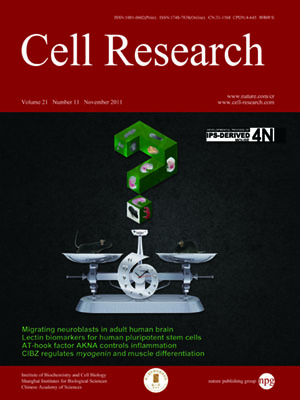
Volume 21, No 11, Nov 2011
ISSN: 1001-0602
EISSN: 1748-7838 2018
impact factor 17.848*
(Clarivate Analytics, 2019)
Volume 21 Issue 11, November 2011: 1619-1633
ORIGINAL ARTICLES
Xbp1-mediated histone H4 deacetylation contributes to DNA double-strand break repair in yeast
Ran Tao1, Hua Chen1, Chan Gao1, Peng Xue2, Fuquan Yang2, Jing-Dong J Han3,4, Bing Zhou1 and Ye-Guang Chen1
1The State Key Laboratory of Biomembrane and Membrane Biotechnology, Department of Biological Sciences and Biotechnology, Tsinghua University, Beijing 100084, China
2Institute of Biophysics, Chinese Academy of Sciences, Beijing 100101, China
3CAS Key Laboratory of Molecular Developmental Biology and Center for Molecular Systems Biology, Institute of Genetics and Developmental Biology, Chinese Academy of Sciences, Beijing 100101, China
4CAS Key Laboratory for Computational Biology, Chinese Academy of Sciences-Mas Planck Partner Institute for Computational Biology, Shanghai Institutes for Biological Sciences, Chinese Academy of Sciences, 320 Yueyang Road, Shanghai 200031, China
Correspondence: Ye-Guang Chen,(ygchen@tsinghua.edu.cn)
Xbp1 has been shown to regulate the cell cycle as a transcriptional repressor in budding yeast Saccharomyces cerevisiae. In this study, we demonstrated that Xbp1 regulates DNA double-strand break (DSB) repair in S. cerevisiae. Xbp1 physically and genetically interacts with the histone deacetylase Rpd3 complex. Chromatin immunoprecipitation revealed that Xbp1 is required for efficient deacetylation of histone H4 flanking DSBs by the Rpd3 complex. Deletion of XBP1 leads to the delayed deacetylation of histone H4, which is coupled with increased nucleosome displacement, increased DNA end resection and decreased non-homologous end-joining (NHEJ). In response to DNA damage, Xbp1 is upregulated in a Mec1-Rad9-Rad53 checkpoint pathway-dependent manner and undergoes dephosphorylation. Cdk1, a central regulator of S. cerevisiae cell cycle, is responsible for Xbp1 phosphorylation at residues Ser146, Ser271 and Ser551. Substitution of these serine residues with alanine not only increases the association of Xbp1 with the Rpd3 complex and its recruitment to a DSB, but also promotes DSB repair. Together, our findings reveal a role for Xbp1 in DSB repair via NHEJ through regulation of histone H4 acetylation and nucleosome displacement in a positive feedback manner.
Cell Research (2011) 21:1619-1633. doi:10.1038/cr.2011.58; published online 5 April 2011
FULL TEXT | PDF
Browse 1975


